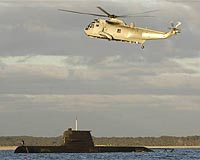| . |  |
. |
Canberra, Australia (UPI) Nov 6, 2009 The Ministry of Defense has awarded a contract to the Rand Corp. to report on the country's manufacturing capability to produce a dozen submarines. The contract award is the first concrete step in Australia's most expensive ever defense procurement project, expected to be around $17 billion. Greg Combet, acting minister for defense, announced the contract to complete a "Domestic Design Study for the Future Submarine Project," SEA 1000. "As outlined in the White Paper, the government has decided to acquire 12 new Future Submarines, to be assembled in South Australia," Combet said in a written statement. "This project will be the largest and most complex defence procurement undertaken in Australia's history. The Rand Corp. brings internationally recognized expertise to the Domestic Design Study having completed similar studies for both the United States and United Kingdom governments." The study is to be finished by February, and the government has previously stated that it wants to start detailed design work for the first boat by 2013, with the boats being built in Adelaide. The government's main defense procurement body, the Defence Materiel Organization, will then consider its options based on the Rand research about which companies have the physical capability and strategic knowledge to work on the manufacturing and supply contracts, Combet said. A request for tender for the study went out in August after the defense white paper, published in May, noted that the six Collins-class submarines with the Royal Australian Navy will be replaced by 12 conventional submarines by around 2025. Their operational life could extend "well into the 2050s and possibly beyond," the document said. Close cooperation with U.S. companies is likely. The 3,000-ton diesel-electric Collins-class boats were built by ASC, formerly the Australian Submarine Corp., between 1996 and 2003. They replaced six Oberon-class vessels commissioned between 1967 and 1978. ASC is a wholly government-owned defense company based at Osborne in Adelaide, South Australia. It has the contract to maintain its Collins-class submarines for their operational lifespan under a $3 billion contract. For this reason ASC looked well placed, at least on paper, to get a large chunk of any future submarine replacement build-and-maintain work. However, in late September the government let it be known that it was not happy with the performance of ASC over its maintenance of the Collins-class boats. In a verbal shot over the bow of ASC, an unnamed government source was quoted in the media saying that the navy could get no more than three of its Collins-class boats to sea at any one time because of repair issues and scheduling. ASC was also criticized for not acting swiftly to hire a new chief executive, despite an international search, and that ASC could not draw on the best international talent. ASC has ongoing business with the government through its 2005 contract as the preferred shipbuilder for three AEGIS-based Australian air warfare destroyers. The ships are being built under the SEA 4000 project and are scheduled for service in 2013. In February the Ministry of Defense appointed Rear Adm. Rowan Moffitt to head the Future Submarine Program, SEA 1000. Share This Article With Planet Earth
Related Links Naval Warfare in the 21st Century
 Future Submarine Design Capability Study
Future Submarine Design Capability StudyCanberra, Australia (SPX) Nov 04, 2009 Greg Combet, Acting Minister for Defence, has announced that a contract had been signed with the United States RAND Corporation to complete a Domestic Design Study for the Future Submarine Project, SEA 1000. "As outlined in the White Paper, the Government has decided to acquire 12 new Future Submarines, to be assembled in South Australia. This project will be the largest and most complex ... read more |
|
| The content herein, unless otherwise known to be public domain, are Copyright 1995-2009 - SpaceDaily. AFP and UPI Wire Stories are copyright Agence France-Presse and United Press International. ESA Portal Reports are copyright European Space Agency. All NASA sourced material is public domain. Additional copyrights may apply in whole or part to other bona fide parties. Advertising does not imply endorsement,agreement or approval of any opinions, statements or information provided by SpaceDaily on any Web page published or hosted by SpaceDaily. Privacy Statement |